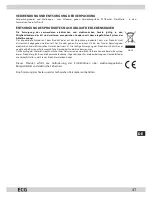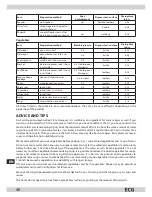
44
EN
3. Assemble the new dehydrator and let it run without foods for approximately 30 minutes. Then wait, until
the dehydrator cools down. Wash the trays and the lid of the dehydrator with warm water and wipe the
base of the dehydrator from outside with wet cloth.
PROCESS
1.
Wash and dry all the foods before you prepare them for drying. Select only undamaged foods for
preparation for drying, cut out the damaged places. Remove pits and cores from the fruit. Prepared fruit
should be ripe, but not overripe.
2.
The drying process will be even when you slice the food in evenly thick slices (about 0.6 cm). Thin slices
dry faster, but remember that the drying process reduces their size substantially. Place the unpeeled fruit
peel down, with the cut side on top. Place the uneven shapes on the side with the peel, not on the cut
side. Spread the vegetables evenly in a single layer. Dry the herbs very gently. Remove only the stem, do
not slice the herbs any further. You have to turn leafy herbs during the drying process to prevent sticking.
3.
Spread the pieces evenly on the dehydrator tray, do not put one on top of another and leave spaces
between individual pieces. Use about 85% of each dehydrator tray area to ensure proper air circulation.
Note:
To prevent browning of some types of fruit, we recommend that you pretreat the fruit before drying by
immersing it into a solution of 1 tablespoon of lemon juice and a cup of water, then dry it with paper towel.
You can replace the lemon juice with pineapple juice or with commonly available vitamin C. Some fruits have
natural protective wax coating, e.g. fi gs, plums, grapes, blueberries, etc.
Immerse them in boiling water for 1–2 minutes, drain and immerse immediately in cold water and dry off .
Slice and dehydrate. Pores in the peel open and the drying will speed up.
Blanching
Most kinds of produce should be blanched before drying. Blanching limits any change to appearance and
taste of the treated products. It is scalding or boiling of fruit and vegetables for a short time (1–5 minutes).
Place the prepared produce (e.g. carrots, celery) in a wire basket or strainer and immerse it in a pot of boiling
water. Dry completely before putting it in the dehydrator.
Blanching in a suitable solution helps to preserve the colour of apples, apricots, fi gs, nectarines, peaches, pears
and plums. The result will be sweetened candied fruit. It is necessary to try the eff ectiveness of these methods.
You can soak fruit and vegetables in these solutions:
•
Compared to other methods, lemon juice and pineapple juice are the natural way how to preserve colour.
•
Sodium sulphite: Buy the product for food preparation in the pharmacy.
•
Citric and ascorbic acid add “a sour taste of vitamin C” to the product.
•
Blanching in boiling water or steam
•
Blanching in juice will help to preserve the colour of apples, apricots, fi gs, nectarines, peaches, pears and
plums. The result will be sweetened candied fruit.
4.
Set the required drying temperature with the temperature control.
The minimum number of trays to
ensure proper drying is 5!
Types of food
Recommended temperature
Flowers
35 – 40 °C
Herbs
40°C
Baked goods
40 – 50 °C
Vegetables
50 – 55 °C
Fruit (apples)
55 – 60 °C
Fruit (pears)
55 – 60 °C
Fruit (apricots, peaches, plums)
55 – 60 °C
Meat, fi sh
65 – 70 °C









































